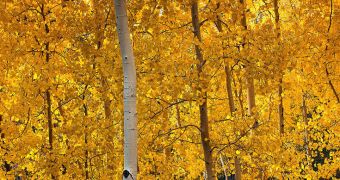A new scientific study demonstrates that seemingly-immortal aspen tree clones also die at a certain point, even though it takes up to tens of thousands of years for that to happen.
These organisms essentially clone themselves, which allows them to live for millennia. But researchers recently identified a crack in this ability that makes the trees vulnerable to the passage of time as well.
The experts say that, as generations of quaking aspen trees are cloned, genetic mutations slowly build up within the new organisms.
As this happens, pollen production is decreased, until it's eventually stopped in its entirety. The team behind the work admits that it takes however tens of thousands of years for that to happen.
What these trees do is they create clones of themselves by sprouting new trees from the tip of their roots. However, as time passes, they will become unable to produce seeds.
Without seeds, the plants would essentially be stuck in one place, which means that they will become vulnerable to natural disasters and diseases, as well as various sorts of infections.
“There’s a slow and steady loss of fertility with age,” explains expert Dilara Ally, who is based at the San Diego State University (SDSU).
“Because we were able to calculate the rate at which male fertility was lost, we could estimate how long it would take fertility in the oldest clone to dwindle away entirely,” the scientist adds.
She is the author of a new scientific study published in the August 17 issue of the open-access scientific journal PLoS Biology, which details a correlation between age, pollen production and genetic mutations.
“I never really believed that anything could live forever. We just didn’t have a way of showing how they aged,” Ally says, quoted by Wired.
The expert says that a 10,000-year-old aspen clone was found to produce only 25 percent the amount of pollen the initial organisms had set out with.
This gave researchers a method of estimating the maximum time it would take for a forest sprouted from a single tree to loose its ability to produce viable seeds.
The numbers are not set in stone, and are meant more as a guideline, the team says.

 14 DAY TRIAL //
14 DAY TRIAL //